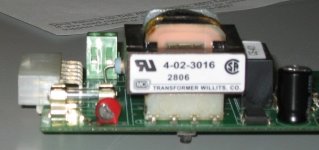Brijm
Lifetime Supporting Member
I have a customer who burnt up a trace, and a capacitor on his pellet stove control board. They do not repair these boards, and a new one costs some $. I know a few here work with electronics, and thought someone might be able to give me an idea on what size capacitor to get. He knows the board may be damaged further, and would like to give it a shot to repair.
The Capacitor is connected to the fused incoming power and the outside leg of the transformer, and the second leg of the transformer. (I'm guessing the filter capacitor). I haven't done board work since school, so any help would be appreciated.
Thanks,

The Capacitor is connected to the fused incoming power and the outside leg of the transformer, and the second leg of the transformer. (I'm guessing the filter capacitor). I haven't done board work since school, so any help would be appreciated.
Thanks,




